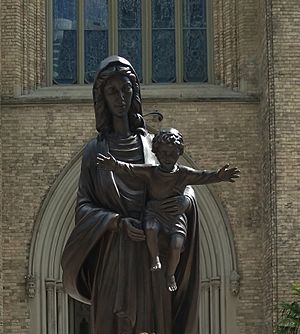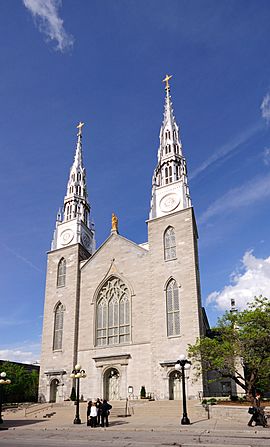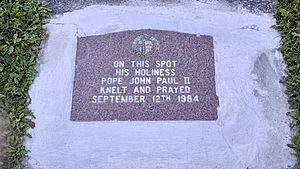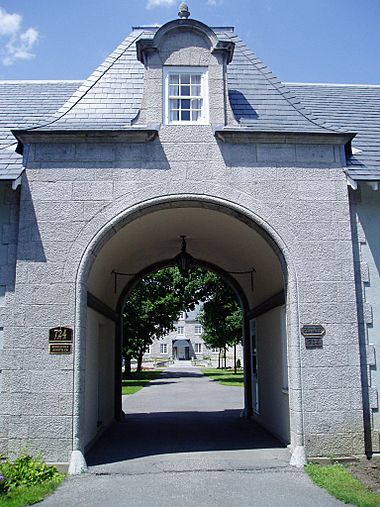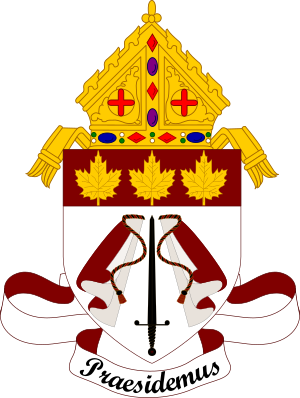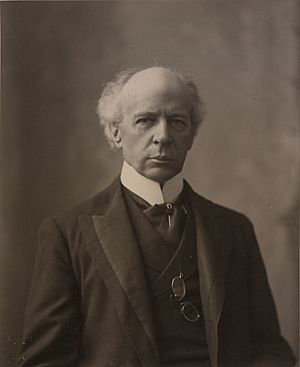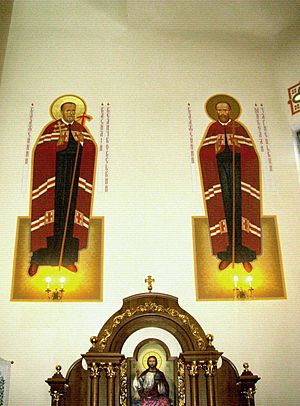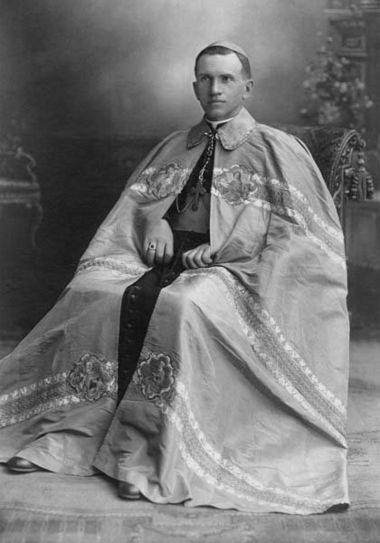Catholic Church in Canada facts for kids
Quick facts for kids Catholic Church in Canada |
|
|---|---|
| English: Catholic Church in Canada French: Église catholique au Canada |
|
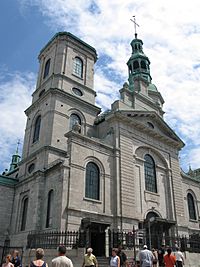
|
|
| Type | National polity |
| Classification | Catholic |
| Orientation | Latin |
| Scripture | Bible |
| Theology | Catholic theology |
| Governance | CCCB |
| Pope | Francis |
| President | Lionel Gendron |
| Primate | Gérald Lacroix |
| Apostolic Nuncio | Ivan Jurkovič |
| Associations | Canadian Council of Churches |
| Region | Canada |
| Language | English, French, Latin |
| Origin | 16th century New France, French North America |
| Members | 38.7% of Canadians (12,810,705 as of 2011) |
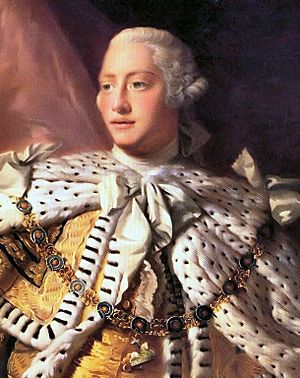
The Catholic Church in Canada is a part of the worldwide Catholic Church. It has a special structure where each local bishop leads their area. However, they all follow the spiritual guidance of the Pope and the Canadian Conference of Catholic Bishops. In 2021, about 29.4% of Canadians, which is 10.8 million people, identified as Catholic. This makes it the largest Christian group in Canada. There are 73 Catholic areas (called dioceses) and about 7,000 priests across Canada. On a typical Sunday, about 15% to 25% of Catholics in Canada attend Mass.
Contents
History of Catholicism in Canada
Early Days of Catholicism
Catholicism first came to the land we now call Canada around the year 1000. This was when Leif Ericson and his family landed at L'Anse aux Meadows. His mother had become Catholic, bringing the faith to Greenland and then to this new land.
Later, in 1497, John Cabot landed on Newfoundland. He raised flags from Venice and the Pope, claiming the land for King Henry VII of England. He also recognized the Catholic Church's authority. A letter from John Day says Cabot landed on June 24, 1497. He brought a crucifix and flags of the Pope and the King of England.
In 1608, Samuel de Champlain started the first Catholic settlement in Quebec City.
Missionary work with Indigenous peoples began in the early 1610s. This was a condition set by the King of France for colonization. Jessé Fleché, a priest, was one of the first to baptize many Indigenous people. Later, in 1611, the Society of Jesus (Jesuits) started their work in Acadia. They learned local languages and lived with the Mi'kmaq people to teach them about Catholicism.
In 1620, George Calvert, 1st Baron Baltimore bought land in Newfoundland. He named his colony Avalon. In 1627, he brought two Catholic priests there. This was the first time Catholic ministry was continuously offered in British North America. Calvert made sure Catholics could practice their faith freely in Newfoundland. He believed in religious tolerance, which was a new idea at the time. This principle was written into the rules for Avalon and later for Maryland. So, the Colony of Avalon was the first place in North America to practice religious tolerance.
British Rule and Challenges
After the British took over New France in 1759, it became a British colony. However, the Catholic Church continued to grow in Canada. This was because the Treaty of Paris (1763) allowed the British to protect Catholicism and French-speaking people. This historical agreement still affects Canadian society today.
Difficulties for Catholics
In the 1800s, some people, especially Protestant Irish immigrants, were worried about the Catholic Church. In 1853, riots in Quebec, known as the Gavazzi Riots, led to 10 deaths. This happened after Catholic Irish people protested against anti-Catholic speeches.
A big issue was public support for Catholic French-language schools. The Confederation Agreement of 1867 said that Catholic schools, where they were legal, would keep their status. But arguments broke out in many provinces. This was especially true in Manitoba in the 1890s and Ontario in the 1910s. In Ontario, a rule called Regulation 17 limited French as a teaching language to only the first two years of school. French Canadians strongly opposed this rule. This conflict, which started over language, also became a religious issue. During World War I, this rule was one reason why many young French Canadian men did not join the war effort.
Protestants managed to stop the growth of French-language Catholic public schools. Irish Catholics often supported the English language position. Despite this, French language education in Ontario continues today in both Catholic and public schools.
French vs. Irish Catholics
From the 1840s to the 1920s, there was a big difference between French Canadian Catholics and English-speaking Irish Catholics. French Catholics, mostly in Quebec, saw themselves as especially true Catholics. They were upset that Irish Catholics sometimes worked with Protestants, especially on the school issue.
The Irish Catholics had an advantage because the Vatican (the Pope's home) favored them. Irish Catholics were "ultramontane", meaning they were very loyal to the Pope. French bishops in Canada, however, were more independent from the Vatican. The conflict over Regulation 17 in Ontario during the First World War made French Canadians feel even more distant from the English-speaking establishment.
Over time, Irish Catholics gained more control of the Church in most provinces outside Quebec. Today, French-speaking Catholics tend to be more liberal than English-speaking ones. They are also leaving the faith more quickly.
Newfoundland's Catholic History
In the Dominion of Newfoundland (which joined Canada in 1949), politics were often divided by religion. Protestants and Irish Catholics had different views.
The Catholic Church in St. John's, Newfoundland, began to grow after Catholics gained religious freedom in 1784. This was made clear by Governor John Campbell. James Louis O'Donel was appointed as the first leader for Catholics in Newfoundland. This was the first official Catholic area in English-speaking North America.
In 1861, the Protestant governor removed Catholic Liberals from office. The election that followed was very chaotic. Both the Anglican bishop and the Catholic bishop took sides. The Protestants elected Hugh Hoyles as Prime Minister. Hoyles then worked to calm things down. He shared power and jobs fairly between different religious groups. This "denominational compromise" also extended to education. All religious schools received funding, similar to what Catholic schools had since the 1840s.
Newfoundland's religious schools were funded by the province until the late 1990s. In 1998, Newfoundland changed to a school system that was not based on religion. This followed public votes and court decisions.
Recent Events in the Church
Papal Visits to Canada
In 1984, John Paul II became the first Pope to visit Canada. He visited the country three times in total. His last visit was for World Youth Day 2002 in Toronto. Pope Francis also visited in July 2022. He came to apologize for the role of some Catholics in residential schools.
Changes in Church Membership
Between 2001 and 2013, the number of Canadians who identified as Catholic stayed about the same, around 12.8 million. Catholics remained the largest Christian group. However, fewer people are attending church services. This has led to more churches closing across Canada.
Church Fires in 2021
In 2021, after more people learned about residential schools, some Catholic churches on First Nations reserves in western Canada were destroyed by fires. Investigators thought these fires were suspicious. Other churches were also damaged. Both the Catholic Church and Indigenous leaders spoke out against these burnings.
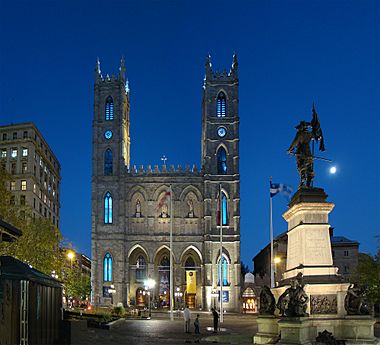
Catholic Population in Canada
The table below shows the number of Catholics in Canada in 2001 and 2011.
| Historical population | ||
|---|---|---|
| Year | Pop. | ±% |
| 1871 | 1,532,471 | — |
| 1881 | 1,791,982 | +16.9% |
| 1891 | 1,992,017 | +11.2% |
| 1901 | 2,229,600 | +11.9% |
| 1911 | 2,833,041 | +27.1% |
| 1921 | 3,389,626 | +19.6% |
| 1931 | 4,102,960 | +21.0% |
| 1941 | 4,806,431 | +17.1% |
| 1951 | 6,069,496 | +26.3% |
| 1961 | 8,342,826 | +37.5% |
| 1971 | 9,974,895 | +19.6% |
| 1981 | 11,210,385 | +12.4% |
| 1991 | 12,203,620 | +8.9% |
| 2001 | 12,936,910 | +6.0% |
| 2011 | 12,810,705 | −1.0% |
| 2021 | 10,880,360 | −15.1% |
| Province | 2001 | 2011 | % Change 2001–2011 |
% 2001 | % 2011 | Δ% Change 2001–2011 |
|---|---|---|---|---|---|---|
| 5,939,715 | 5,766,750 | -2.9% | 83.4% | 74.5% | -8.9% | |
| 3,911,760 | 3,948,975 | +1.0% | 34.7% | 31.2% | -3.5% | |
| 786,360 | 850,355 | +8.1% | 26.7% | 23.8% | -2.9% | |
| 675,320 | 679,310 | +0.6% | 17.5% | 15.0% | -2.5% | |
| 386,050 | 366,000 | -5.2% | 53.6% | 49.7% | -3.9% | |
| 328,700 | 297,655 | -9.4% | 36.6% | 32.8% | -3.8% | |
| 323,690 | 294,495 | -9.0% | 29.3% | 25.0% | -4.3% | |
| 305,390 | 287,190 | -6.0% | 31.7% | 28.5% | -3.2% | |
| 187,440 | 181,550 | -3.1% | 36.9% | 35.8% | -1.1% | |
| 63,265 | 58,880 | -6.9% | 47.4% | 42.9% | -4.5% | |
| 16,990 | 15,755 | -7.2% | 45.8% | 38.7% | -7.1% | |
| 6,215 | 7,580 | +22.0% | 23.3% | 23.9% | +0.6% | |
| 6,015 | 6,095 | +1.3% | 21.1% | 18.3% | -2.8% | |
| 12,936,905 | 12,728,885 | -1.6% | 43.6% | 38.7% | -4.9% |
The number of Catholics in Canada saw its first recorded decrease between 2001 and 2011. Quebec saw a notable drop in its Catholic population. Smaller provinces also saw decreases. However, larger English-speaking provinces like Ontario, British Columbia, and Alberta saw a rise in Catholics. There are also members of Eastern Catholic Churches in Canada, especially Ukrainians.
How the Church is Organized
The Catholic Church in Canada is decentralized. This means each local bishop leads their own area (diocese). They are connected to the Canadian Conference of Catholic Bishops (CCCB) but are not directly controlled by it. The CCCB divides Canada into four main groups of bishops: the Atlantic Episcopal Assembly, the Assemblée des évêques catholiques du Québec, the Assembly of Catholic Bishops of Ontario, and the Assembly of Western Catholic Bishops. The Pope has a representative in Canada called the Apostolic Nunciature to Canada, located in Ottawa.
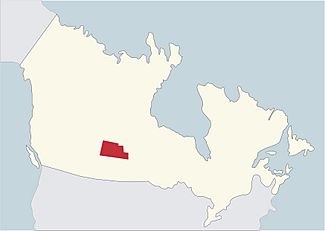
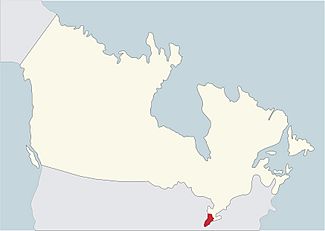
Here are some of the main Catholic areas in Canada:
- Archdiocese (a larger area led by an Archbishop)
- Diocese (a smaller area led by a Bishop)
|
There is also a Military Ordinariate of Canada that serves Canadian military personnel.
Eastern Catholic Churches in Canada
Besides the main Latin Church, there are also Eastern Catholic Churches in Canada. These churches have their own traditions and rites, but they are in full communion with the Pope.
One example is the Ukrainian Greek Catholic Church. It has a main area called the Archeparchy of Winnipeg and four smaller areas (eparchies):
- Ukrainian Catholic Eparchy of Edmonton
- Ukrainian Catholic Eparchy of New Westminster
- Ukrainian Catholic Eparchy of Saskatoon
- Ukrainian Catholic Eparchy of Toronto and Eastern Canada in Toronto.
Other Eastern Catholic groups in Canada include:
- Melkite Eparchy of Saint-Sauveur de Montréal
- Romanian Catholic Eparchy of St George's in Canton (covers all of North America)
- Slovak Exarchate of Saints Cyril and Methodius of Toronto
- Maronite Eparchy of Saint-Maron de Montréal
- Chaldean Catholic Eparchy of Mar Addai of Toronto
- Syrian Catholic Apostolic Exarchate for Canada
- Syro-Malabar Catholic Eparchy of Mississauga
Famous Canadian Catholics
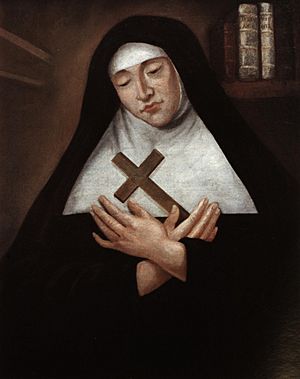
Patron Saint of Canada
Saint Joseph is the Patron Saint of Canada.
Notable Canadian Catholics
Many famous Canadians have been Catholic, including:
- Neil McNeil (1851–1934)
- Bernard Lonergan (1904–1984)
- Marshall McLuhan (1911–1980)
- Paul Desmarais (1927–2013)
- Charles Taylor (philosopher) (1931–present)
- Marc Garneau (1949–present)
- John Candy (1950–1994)
- Catherine O'Hara (1954–present)
- Wayne Gretzky (1961–present)
- Celine Dion (1968–present)
- Neve Campbell (1973–present)
Prime Ministers of Canada
Several Canadian Prime Ministers have been Catholic:
- Sir John Thompson (1845–1894)
- Wilfrid Laurier (1841–1919)
- Louis St. Laurent (1882–1973)
- Pierre Trudeau (1919–2000)
- Joe Clark (1939–present)
- John Turner (1929–2020)
- Brian Mulroney (1939–present)
- Jean Chrétien (1934–present)
- Paul Martin (1938–present)
- Justin Trudeau (1971–present)
Other Notable Catholics
- Jim Carrey (1962–present) (practices Transcendental Meditation)
Saints from Canada
These are people recognized by the Catholic Church for their holy lives:
- François de Laval
- Frère André
- Kateri Tekakwitha
- Marguerite Bourgeoys
- Marguerite D'Youville
- Marie de l'Incarnation
- Canadian Martyrs (a group of missionaries)
- Isaac Jogues
- Antoine Daniel
- Jean de Brébeuf
- Gabriel Lalemant
- Charles Garnier
- Noël Chabanel
- René Goupil
- Jean de Lalande
Blessed People from Canada
These individuals are recognized as "Blessed" by the Catholic Church:
- Catherine de Saint-Augustin
- Dina Bélanger
- Émilie Tavernier Gamelin
- Frédéric Janssoone
- Louis-Zéphirin Moreau
- Marie-Élisabeth Turgeon
- Marie-Léonie Paradis
- Marie-Rose Durocher
- Nykyta Budka
- Vasyl Velychkovsky
Venerable People from Canada
These individuals are recognized as "Venerable" by the Catholic Church, meaning they lived lives of heroic virtue:
- Alfred Pampalon
- Anthony Kowalczyk
- Élisabeth Bergeron
- Délia Tétreault
- Vital-Justin Grandin
See also
 In Spanish: Iglesia católica en Canadá para niños
In Spanish: Iglesia católica en Canadá para niños
- Canadian Conference of Catholic Bishops
- Catholic sisters and nuns in Canada
- List of Catholic dioceses in Canada
- List of Canadian Catholic saints
- Protestantism in Canada


